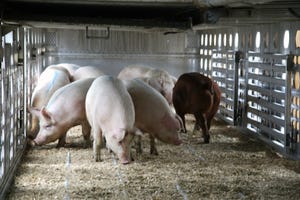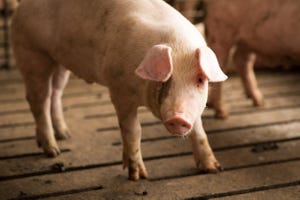Creating an audit trail for your Prop 12 compliance
Maintaining an audit trail will help provide breeding pig location events, as well as trace compliant wean pig flow to nursery and finish barns.
June 13, 2023

The recent determination of the United States Supreme Court in favor of upholding California's Prop 12 on May 11 has left a lot of pork producers still deciding next steps. While a few have already begun to transition their buildings to adopt the regulations when the legislation was first passed, other producers plan to remain non-compliant as long as there is a market for their product.
In speaking with Jacquelyn Babcock, director of Animal Welfare Auditing and Training at FACTA, one of the first accredited certifying agencies registered with the California Food and Agriculture Animal Care Program, she clarified that for those that have made the decision to certify a farm as "Pork CA Prop 12 Compliant" for pork sold into California as of July 1, you will need to submit a self-certification of compliance or valid third-party certification along with your application for registration. After January 1, 2024, you will need to submit a valid third-party certification along with your application for a new registration and for the purposes of registration renewal.
Audit trail
Producers committed to selling Pork CA Prop 12 Compliant pork should understand the level of detailed record keeping and documentation required. Records are required to be maintained for two years from the date of creation and be made accessible for inspection and audit by the department and/or an accredited certifying agent.
Regardless of what record keeping system is used on farm to manage your herd inventory and performance records; it will be essential to keep proper documentation of the Prop 12 compliant regulation changes you have invested in. Maintaining an audit trail will give you the ability to provide breeding pig location events, as well as trace compliant wean pig flow to nursery and finish barns, and finally, label market hog shipments you provide to the Prop 12 Registered Pork Distributor.
Compliant Inventory Management
There are three main areas of inventory management to address in record keeping: sow, wean and feeder pigs, and market hogs.
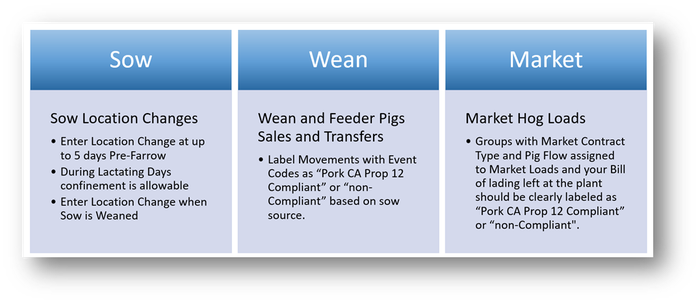
Documenting Sow Location Movements
There are two allowable breeding pig space exceptions found in 1324.1. Confinement Standards Exceptions:
(f) To a breeding pig during the five-day period prior to the breeding pig's expected date of giving birth, and any day that the breeding pig is nursing piglets.
(g) During temporary periods for animal husbandry purposes for no more than six hours in any 24-hour period, and no more than 24 hours total in any 30-day period.
Record the location and movement of sows during the allowable time in the farrowing crate or when confined during any temporary period. Based on our conversations with Babcock, she reinforced that you are allowed to move the sow into the farrowing crate five days prior to expected farrowing based on average gestation length, but there is no penalty if this date is missed.
If your farm is not already capturing sow location information on farrowing event, now is a good time to begin that practice. Sow farms can use the MetaFarms Sow Mobile app to record sow location changes, either by data entry or by scanning RFID tags during sow location events. Below is a sow history showing location change entries during the sow's farrowing.

Inventory Management - Wean and Feeder Pig Sales & Transfers
Traceability into your weaned pig and feeder pig sales can be accomplished by the use of Event Codes in animal movements. With the use of Event Codes on animal movements, Inventory Management reports are available to summarize compliant and non-compliant pig sales.
Additionally, a Wean Pig Projection report, that uses a customized target farrowing rate and an estimated pre-wean mortality, will help producers anticipate the placement of compliant pig flow.
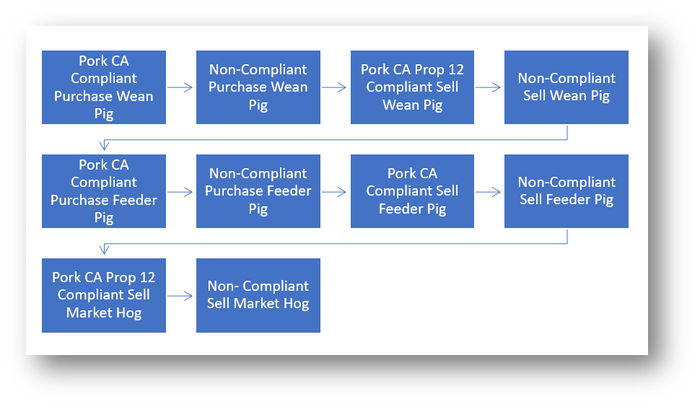
Market Hog Loads in Compliance or non-Compliance
As packers begin to segregate compliant pork, they will be asking that bill of lading documents be clearly marked with either "Pork CA Prop 12 Compliant," or "non-Compliant."
The ultimate goal within your current pork production software should be to find a way to mark groups of pigs as "Pork CA Prop 12 Compliant" or "non-Compliant" if that is the case. MetaFarms has a unique field for Market Contract Type allowing groups or subgroups of pigs to be labeled per market contract. Another label for Pig Flow can also be applied to groups; nursery, finish and wean to finish. This will provide further visibility into your compliant inventory pig flow throughout your production system, from the weaned pig through to market. Inventory Management reports will help with planning production of compliant marketable pigs, as well as non-compliant, assisting in managing those market contracts. Market Contract Type and Pig Flow are both found in the Active Group Summary, Closeout Summary and Market Sales Summary Reports in MetaFarms.
The picture below shows the MetaFarms group labels Market Contract Type and Pig Flow assigned to a Prop 12 Compliant Group.

Being prepared for Prop 12 compliance audits
Building electronic pre-audit checklists can not only help your farms prepare for the initial certification and annual renewals, but it will also give you valuable insight into areas at risk of non-compliance. The assurance audit compliance solution has a successful history of integrating with third party auditors such as FACTA. This will help you prepare for the certification process, as well as maintain your annual compliance, which is especially helpful in larger integrated production systems.
Additionally, Babcock wanted to make us aware that initial certifications and annual renewals are required to be completed in person, with no option for virtual, and with no recourse made for health breaks. For instances of non-conformance discovered during an audit, a farm is given 30 days to make the corrective action and show proof of the correction, then a re-audit is performed. All audits either pass or fail.
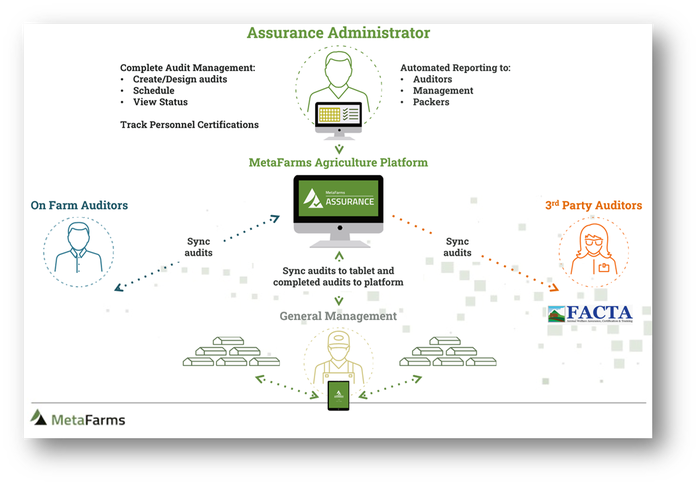
If you would like to discuss how detailed record keeping and maintaining an accurate audit trail can support your investment in Prop 12 Compliance, or if you have suggestions on production areas to be included in future articles, please e-mail or call us. We enjoy being a part of the National Hog Farmer Weekly Preview team. Previous Production Preview columns can be found at National Hog Farmer.
If you have questions or comments about these columns, or if you have a specific performance measurement that you would like us to write about, please contact: Kim Flannery via email.
You May Also Like

